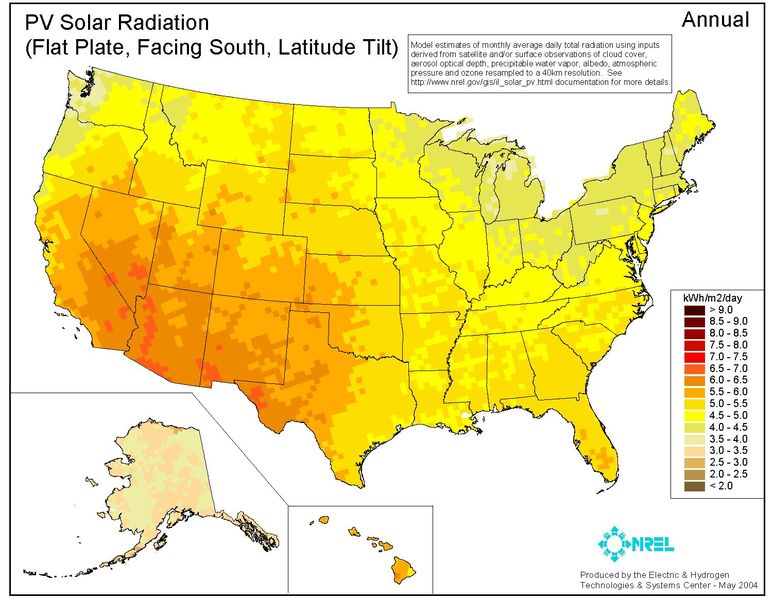You might recall “Aquarius/Let the Sunshine In” as a catchy little tune from the musical Hair, but that’s not what this entry is about…
It turns out that the energy in sunlight is measured at 250 watts/square meter on average across the US, or 3 KWh/square meter/day. See the NREL map below for details.

Now don’t go out and buy solar panels for your roof just yet, not all of that available energy can be directly translated into electricity, the best solar panels are about 15% efficient which means that one might harvest as much as 0.45 KWh/square meter/day into direct current, during day time. Obviously the amount of energy produced is related to location, hours of direct/indirect sunlight, and weather. So just what are these solar panels (photovoltaic cells) anyway?
Photovoltaic (PV) cells are a semi-conductor that absorbs sunlight (photons) into charge carriers (electrons) then directs them to a conductor. Typically, PV cells are grouped into arrays and placed on sheets or panels which in turn are arrayed to generate a desired amount of electricity. Solar panels have been in use for years in space applications, remote sensors, pocket calculators, and increasingly, for individual home power generation (or co-generation.)
There have been some efforts to get to utility scale with PV technology, but the cost remains prohibitive (~$0.20/KWh competing against $0.03-0.07/KWh for other technologies.) Japan and Germany have the most installed PV technology with the largest single installation rated at 12 MW peak production. To put this in perspective, the average fossil fuel plant in the US is rated at 219 MW peak production and the average nuclear plant in the US at 2,000 MW. As costs for PV continue to drop (as they have around 3% per year over the past few years) coupled with fossil fuel cost increases, the point at which PV becomes profitable at scale will likely happen in the next 15 years.
PV power generation does have some distinct advantages including $0 fuel costs, zero-emission power generation, long equipment lifespan, relatively low maintenance costs, and modular application scaling from micro-installations up to small utility size. The disadvantages to solar are in capacity factor, it’s only light so many hours per day and power demands are 24/7. Relatively speaking, it’s expensive to procure and install. And finally, the resulting power is direct current which further degrades efficiency as the power must be “inverted” to use on the grid or in typical AC household power systems. I’ve heard there may be some breakthrough research happening on the production of PV cells that radically change the costs of PV; if this happens, solar may become mainstream faster than any of us would expect.
Google is certainly making a go of it. Recently, the company announced a plan to install solar panels on its buildings (1.6 MW) and that the resulting power would satisfy up to 30% of the company’s energy requirement. Aside from being good for the planet, I presume someone ran the numbers to see this would at least be a slightly positive return on investment.
Ohio State’s 2006 record: 7-0 Next up: Indiana 10/21
Tune: Stray Cat Strut by Stray Cats
Technorati Tags: Energy | Solar | Photovoltaic | Mike Harding Blog
« Invisible Cloak redux
» Bucks bury Hoosiers, 44-3
Energy
Let the sunshine in
10.20.06 | Comment?
« Invisible Cloak redux
» Bucks bury Hoosiers, 44-3









